Plus some interesting and often tragic history of Utah’s west desert.
Yesterday the weather radar and forecast indicated we might finally have a minor break from our recent inversion so I spent most of the day in the west desert in search of blue sky and birds. I found some of both (more blue sky than birds though) and since I’m a history nut I thought I’d include a bit of a historic travelogue in today’s post.
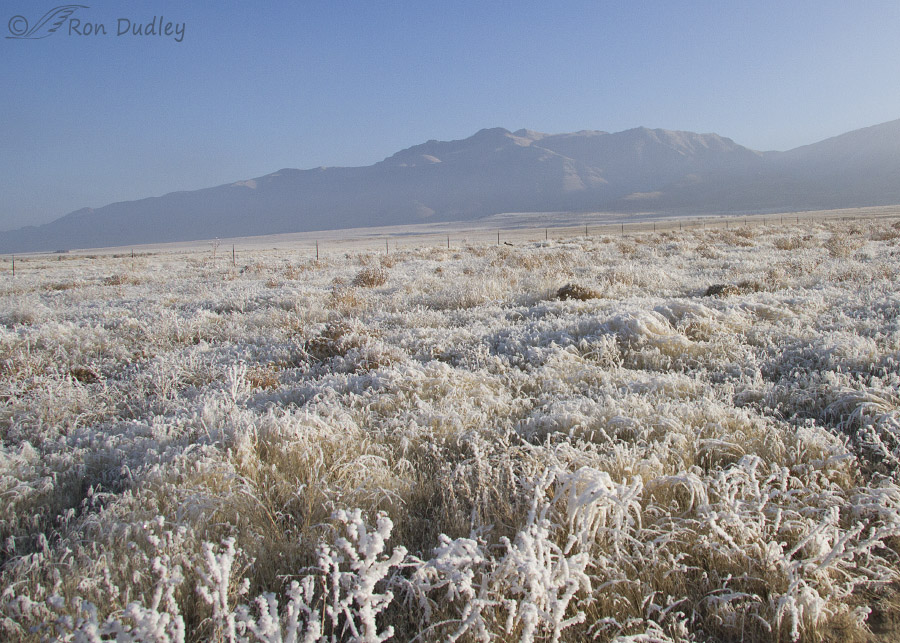
We started out in Skull Valley where temps as low as 12° F. covered absolutely everything with a thick layer of hoar frost. We visited the old ghost town of Iosepa but that early in the morning everything there was backlit so I didn’t take any photos.
Many readers from other parts of the country likely are only aware of remote Skull Valley because of the notorious 1968 Skull Valley Sheep Incident where the army at Dugway conducted an open air VX nerve agent test, killing 8000 sheep in the process, and then lied about it. It was major national news back then and scared the hell out of all us along the Wasatch Front because a wind shift could easily have carried nerve agent our way.

Some history buffs will be well aware of the notorious Hastings Cutoff, an alternative route for California bound pioneers in the mid-1800’s. Because the ill-fated Donner Party took this route in 1846 all of them suffered and many died when they reached the High Sierras, famously eating their own stock animals and each other in their attempt to survive.
Here we see part of the Hastings Cutoff in front of my pickup as it approaches one of the many “island mountain ranges” in the west desert (photo taken in Skull Valley). This is truly desolate (but beautiful) country.
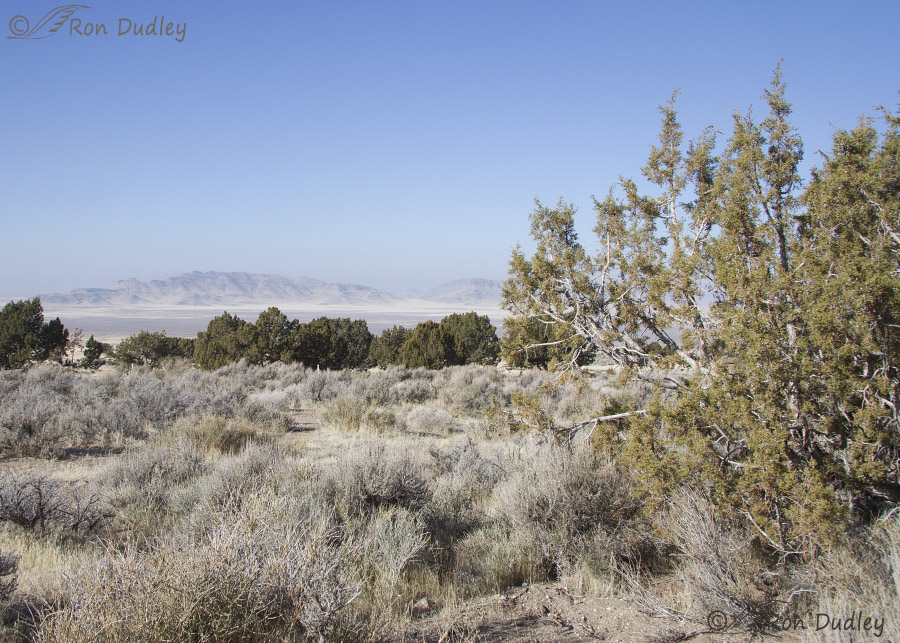
We ended up at Simpson Springs the site of an old Pony Express station. There’s lots of history here too including the more recent tragic story of Susan Cox Powell. From Wikipedia:
- “Susan Cox Powell, an American woman from West Valley City, Utah was last seen alive on December 6, 2009. Her husband Joshua “Josh” Powell was named a person of interest in the investigation, but he was never charged. On February 5, 2012, Josh Powell killed himself and the couple’s two young sons in a murder–suicide after custody of the boys had been awarded to Susan Cox Powell’s parents.”
Josh Powell claimed to have been camping with his young sons at Simpson Springs on the night Susan disappeared and many suspect she is buried in the area of the springs but her body has never been found. That possibility always spooks me a little when I visit Simpson Springs.
But yesterday we were focused on a search for birds and eventually we found a few feeding on juniper “berries” in some of the trees.
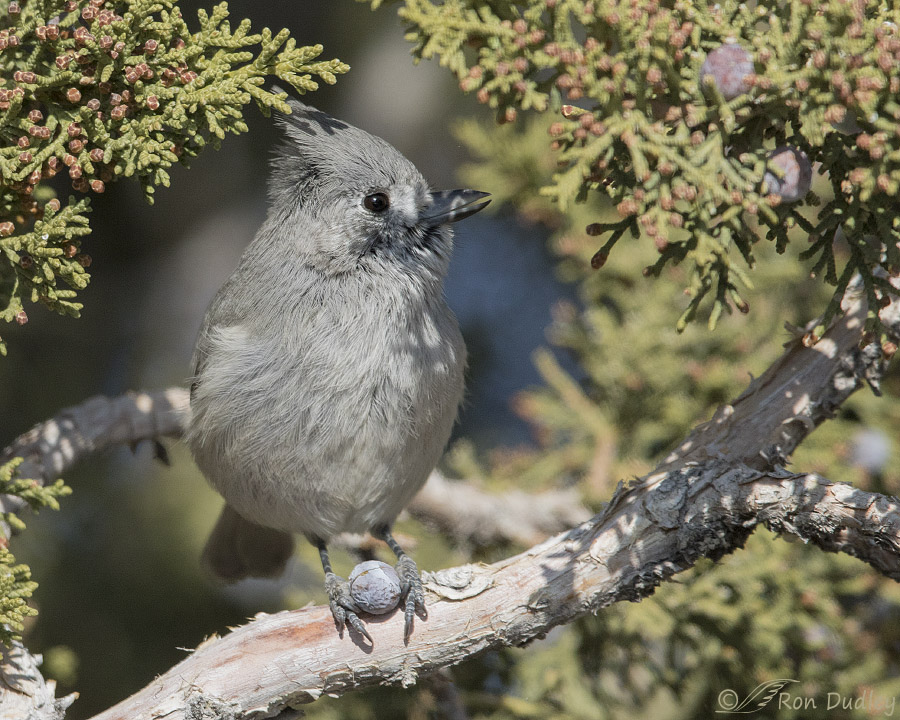
They were Juniper Titmice. Until ten years ago the Juniper Titmouse and the Oak Titmouse were classified as a single species – the Plain Titmouse. Virtually all of the studies that have been done on North American titmice were done on the easier to study “Oak” variety but it turns out that many of the morphologic, colorimetric, genetic, vocal, and ecologic traits of the two species are dramatically different.
So the Juniper Titmouse of today is a surprisingly poorly known species and there is “little published information on their foraging ecology, territoriality, juvenile dispersal, breeding biology, and demography” and little is known of the diet of this species. About all I could find is that it includes both invertebrates and seeds. They’re known to be an important consumer of pinyon pine seeds but I found no mention of their namesake seed in their diet – the Utah Juniper (Juniperus osteosperma).
But that’s exactly what I found this one feeding on. These hard and tough “berries” (they’re really female cones and the juniper species name osteosperma means “bony seed” ) contain only a single seed and they’re difficult to get at so the technique used by this bird was to secure the berry between its feet and hammer away at it with its bill. The hammering sound strongly resembled that of a woodpecker which helped us to locate the birds in the dense vegetation.
This bird had already been hammering a while before this shot was taken but now we can see a thin crack in that tough little berry.
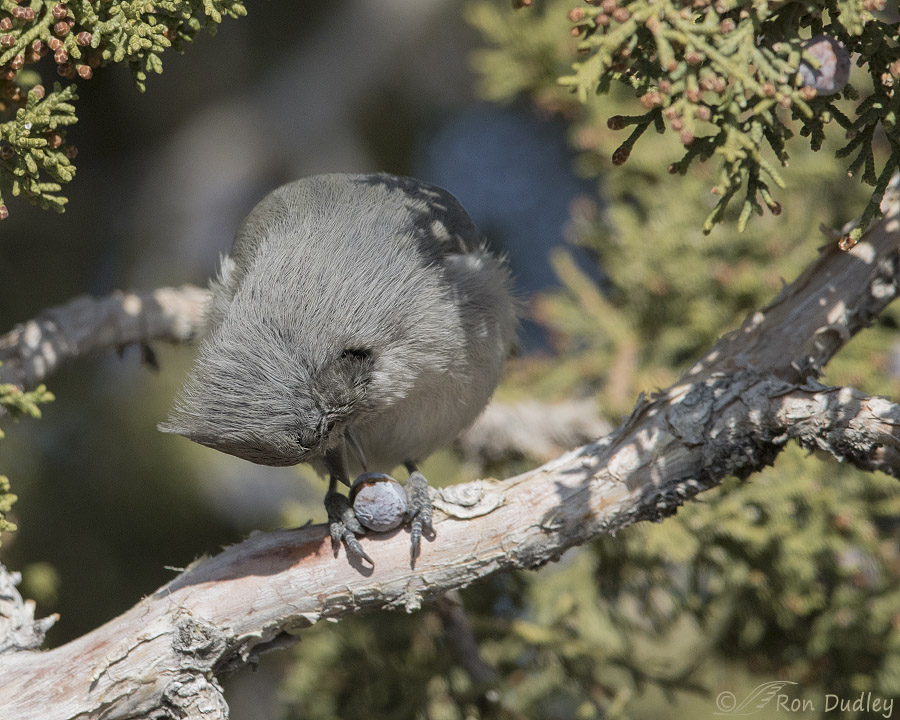
The titmouse hammered some more and then used its bill to wedge the crack open wider…
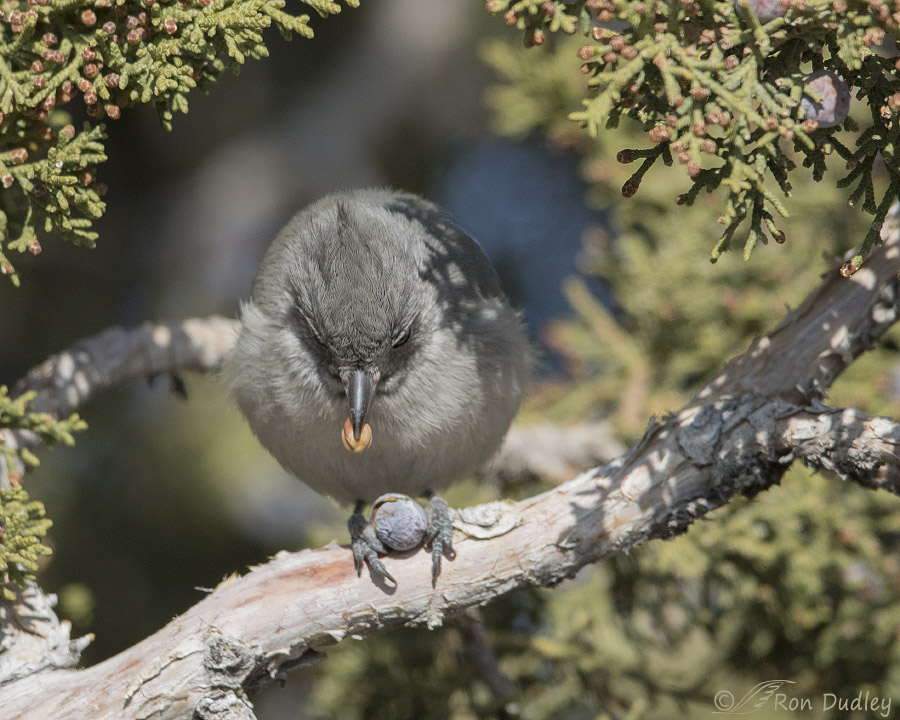
and finally was able to retrieve that precious single seed.
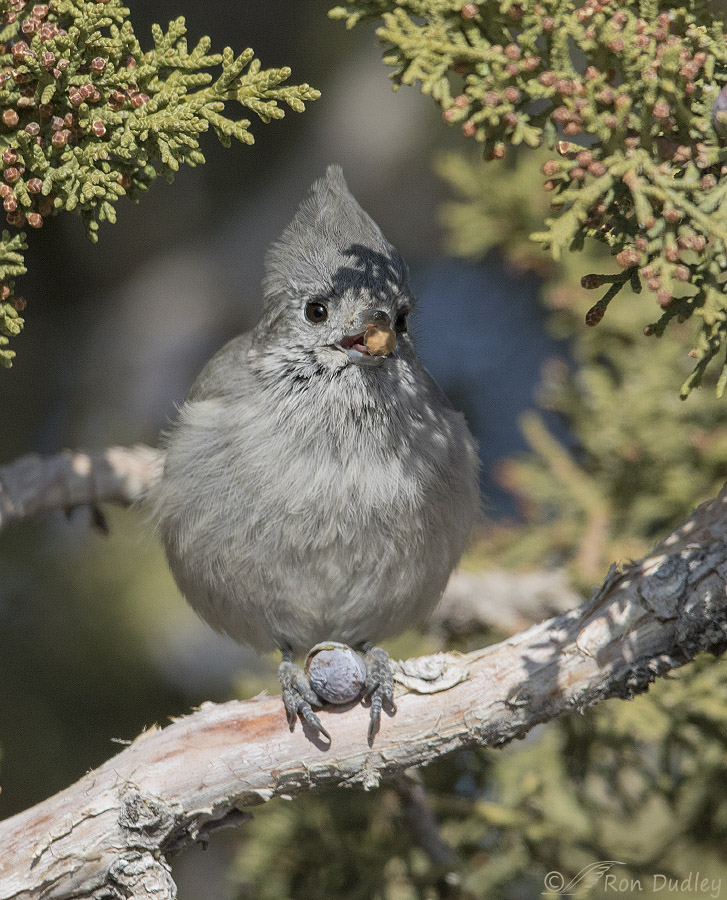
I assumed it would gobble the seed down on the spot but it didn’t.
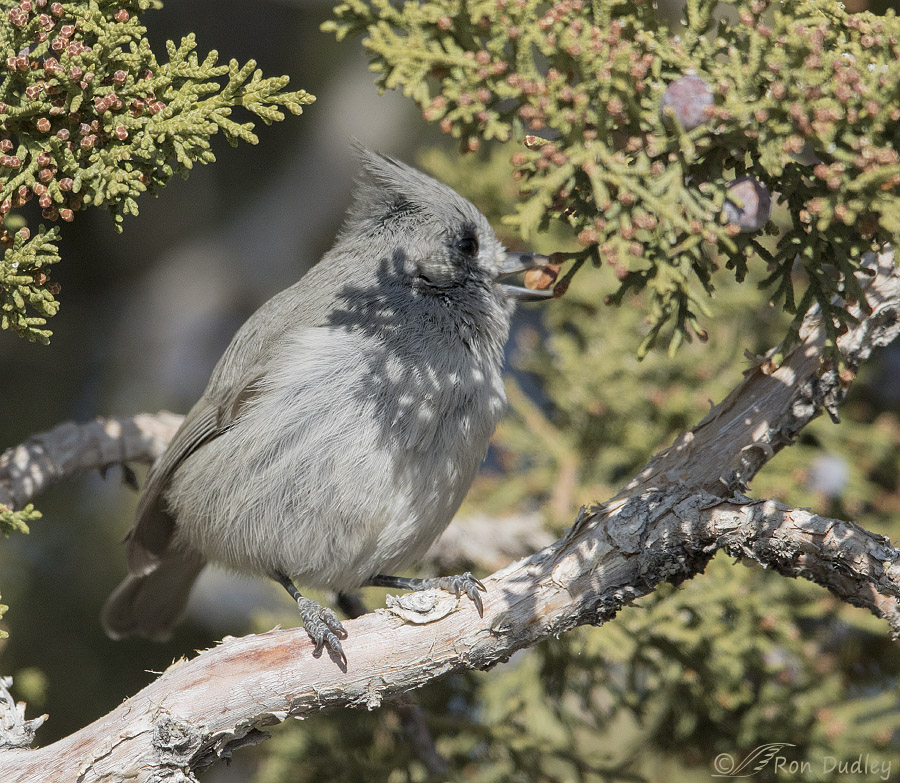
With the seed still in its bill it glanced backwards and then…
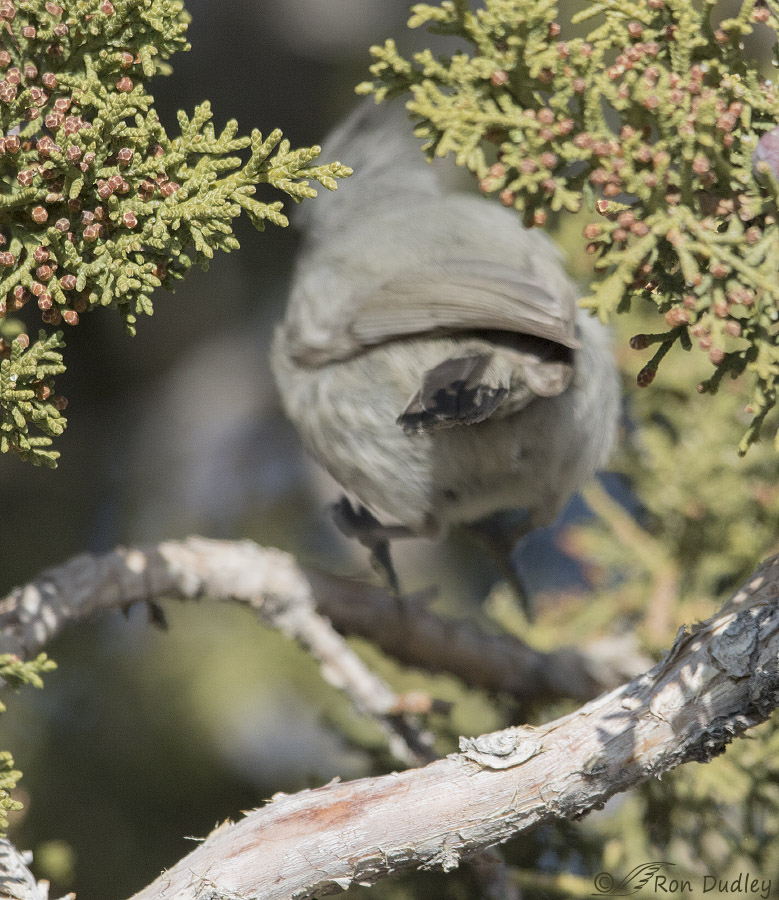
vacated the premises. This species is known to cache food so I suspect that was on its agenda.
As I mentioned previously very little is known about this species. In most areas of study Cornell’s Birds of North America Online simply listed what is known about the Oak Titmouse and sort of hoped that it would also apply to the Juniper Titmouse or they said they had “no information”.
So if you know of any budding ornithologists looking for a study project perhaps the Juniper Titmouse would be a worthy subject.
Ron


Amazing behavioral series Ron!
Charlotte
You certainly have an interesting group of people that reply to your blog…..I think you know what I mean….life is interesting.
Your narrative about the desert surely was interesting to me as a newcomer to Utah. We’ll have to explore it but will make sure to have a full tank of gas and enough food!!
As to your titmouse, what a delightful bird with its interesting habits.
Ron, I enjoy your postings every day. I hope that you enjoy posting them as much as we readers enjoy reading and learning from them.
I’m late to my posting, but had to do it anyway. Thanks so much.
I know I’m late, but I had to say if I was 20 years younger I’d sign up to study this Titmouse! But, alas not in this life!
Great information, story, history, etc. Many thanks for sharing!
Thanks, Dick. I understand that age thing more and more every day!
Dick, I always enjoy your comments. You must be a very interesting person….and probably a teacher like Ron. You are special people and thanks for your posts.
Thank you Alice, that is very nice. Yes, taught for 36 years at the same 9-12 school.
You got me by 3 years, Dick. By the time I had 33 in the “peripheral BS” got to me enough that I just had to retire. I loved it in the classroom but the other stuff just got to be too much.
Yup – “peripheral BS” that is a whole other discussion I won’t go into here, but to say I understand FULLY!
Nope Dick, old ain’t an excuse! You’re still on this side of the dirt, which is a good thing. And as long as you’re on this side of the dirt, anything is possible. I’m seriously considering doing a doctoral program (and I’m older than dirt now). We’re working on the distance thing since I’m out in the middle of nowhere (which is a really good place to be!).
Hey Laura, I always say if I get up on the right side of grass its a good day. Good luck on the doctoral program and being out in the middle of nowhere sounds good to me. But, my ticker and bones say I need to be near a hospital. Tomorrow is my 53 CBC, Christmas Bird Count,it’l be a long but eventful day.
Lovely creature!
Thanks, Nicole.
The titmouse, the wide open spaces, the hoarfrost, the historical housing connections — where do I start? What an abundance in today’s post! Now, off to check out the juniper tree in our yard to see what I can find (usually, it’s just spiders)!
Good luck with your juniper, Marty. With birds you never know!
Just spiders today. :/
Thank you. It looks like harsh and unforgiving country – but is incredibly beautiful with it.
And I loved learning about yet another new (to me) bird.
Thanks, EC. I’m glad you enjoyed your exposure to a new bird for you.
About how long did this entire series take in elapsed time? I love this whole series: my favorite is the shadow of the juniper on its head with the nut visible. Great series here many thanks for my ..”moment of zen…”
“About how long did this entire series take in elapsed time?”
It was a very short time, Diane – my estimation would be between 5 and 10 seconds. But the bird was pounding on the “berry” for significantly longer than that because I heard the hammering long before I got my lens on him/her.
Love your posts. I see things here I would never notice or have the opportunity to travel to. I have been in this area of the west desert and it is beautiful. Thanks also for the education on these wonderful little birds. There are so many in our area that I am familiar with. Great to see some sun as well.
I’m glad you enjoyed the photos and the information, Betty. Thank you.
Beautiful photos. I love roaming the west desert. My parents house in Centerville was built by a Pony Express rider. As I recall he rode from Simpson Springs. He was called Black Bill. His name was William Streeper. My parents have a interesting book the Streeper family put together with photos, history and letters from his life. I believe some of the Streeper carriages and hearse are at Lagoon, and DUP museum.
If you are interested this is a quick synopsis from a family member about William Streeper. The book is interesting due to the many letters and diary entrees written by Streeper.
http://livetruetothefaith.blogspot.com/
How interesting April! I’d love to read the book, but I couldn’t find a way to buy it. I just love reading the accounts of folks who lived in the west during that time! And I’d really like to know how the “Black Bill” name attached to him. OK, in addition to being a critter person, I’m also a book person! LOL!
Laura, I found a partial e-copy. I don’t know if you can barrow the book from this library or possibly get a full e-copy.
https://www.familysearch.org/search/catalog/oclc/21507348?availability=Family%20History%20Library
Sorry Laura, the link won’t work I think when I copied and pasted I missed the first h in https: If you want to e-mail me I can send you info. april.olson@hotmail.com
April, I fixed your link. It works now.
April, I fixed your link so I read the part about “Black Bill” and the pony express. And yes, he rode from and to Simpson Springs. How fascinating that your family home was built by him.
The house that my great-great grandfather built in Willard is still being lived in too (at least it was about 4 years ago). Then his son (my great-grandfather) Joseph Smith Dudley lived in it for many years. He was a fascinating character who killed a man in 1879 for messing with his wife (he was found not guilty after a 5 day trial) but eventually had to move to Canada to escape the notoriety of the killing.
A son and a grandson of his were also named Joseph Smith Dudley so to avoid the confusion in my family history I’ve always affectionately called him “Killer Joe”.
I’m also curious as to why William Streeper was called “Black Bill”.
I love all the shots in this post. Your west desert is my kind of country. The history is very interesting, too. The Juniper Titmouse is a really cute little bird, and I love that you were able to catch it’s behavior with the cone (berry). I’m familiar with the eastern Tufted Titmouse, a frequent visitor to my feeders, when I lived in the east. These days I find it interesting seeing a juniper with both male and female cones on the same tree, since our local species is dioecious.
“These days I find it interesting seeing a juniper with both male and female cones on the same tree, since our local species is dioecious”
Susan, 90% of Utah Juniper trees are monoecious but interestingly 10% are dioecious and produce cones of only one sex.
Well, I’m good for the next week on my learn-something-new-every-day agenda!
What an outrageously beautiful, informational and just overall delightful post! I’m always delighted to learn more about history (especially western history), see hoar frost, the overall Utah countryside, and WOW what a beautiful little titmouse! I’m shocked that this beautiful little guy’s/gal’s species has been mostly ignored, but it just goes to show that we don’t know everything and we don’t know what we don’t know! Oh to be a grad student again!
Anyway, I guess this little titmouse is found largely around junipers, wherever they might be? Do you know if they’re found in other areas/environments?
One of the many cool things about falconry is that when you’re hunting out in the desert, you can find interesting artifacts of bygone days that are mostly intact. The last time I hunted out in the Utah desert, I found a bottle with “Remedy” stamped into the glass. My friend found the best one, though. The bottle he found was stamped with “Female Remedy.” Oh well. You gotta be at the right place at the right time–like you, almost every day! THANK YOU! GADS but I love your posts! Seriously LOVE coming here!
“Do you know if they’re found in other areas/environments?”
Laura, BNA Online lists the following as their preferred habitats: “dry oak–juniper (Quercus–Juniperus) and pinyon–juniper (Pinus–Juniperus) woodlands in the southwestern United States and extreme northern Mexico.”
Sounds like both of us are consumed by an intense interest in history – for me it’s primarily western history and English history (because of my family background) but I really do find all of it interesting. Throw in my interests in anthropology and archaeology and there isn’t enough time in the day…
Ron, one of my bookshelves is devoted entirely to British/Irish/Scottish history…LOL! I’m also with you with archeology and anthropology and throw in geology, too! That’s particularly fascinating in the west when you ask, OK, how did the Earth do THAT? My Master’s degree is in American history with a concentration in Native American history. Add in Native American literature, African American literature and just general literature (No, not the necessarily popular stuff, but the GOOD stuff)–oh and don’t forget the falconry texts and bird books. Yeah, nowhere near enough hours in the day to get it all read, but I’m giving it a great try! I ALWAYS have a book with me–ALWAYS. You just never know when you can read a chapter or two!
My mother called me a bookworm throughout my childhood, but to her, that was a BAD thing. Oh well…can’t please ’em all (sits down with a book now)!
That’s so neat that you were expanding the knowledge base on the diet of this species with your observations. I wonder if Cornell Labs has some method of contributing this type of information. Particularly since you can submit photographic evidence.
I know the Audubon app allows submissions, but I would imagine Ron’s superior photographic skills and biological knowledge might be shared more officially. (Now I have a line about the Book of British Birds from Monty Python in my head.)
Thank you, David.
I’m afraid I’ve pretty much given up sending information and/or images to Cornell. For years their BNA Online account listed “no information” for pellet casting in Western Kingbirds but I’ve photographed them casting pellets at least three times. About 6-7 years ago I sent them some images of the behavior and their editor even asked for my permission to use my images and info on their Western Kingbird account. Which I granted.
Well, guess what. To this day it still says “no information” on pellet casting in Western Kingbirds and they never used my images on BNA Online (or anywhere else that I’m aware of). I’m afraid at this point I’m reluctant to waste any more time sending Cornell anything and that’s too bad…
Ron, I might have an “IN” for you at Cornell. I don’t know if it would work at BNA, but there are other areas. If you’re interested…
Laura, If I remember correctly I was dealing with one of the big shots at BNA. If that didn’t work I don’t know what would…
Well, just (bird) poop on BNA!
Wonderful dialog and fascinating info on a species I had never heard of! Thanks.
Thanks very much, Larry.
I loved this series! What a wonderful way to start a day I expect to get increasingly difficult…You recharge my batteries. l loved both the scenes and the anecdotes that accompany them…You say that writing is difficult for you, but you’d never know it from your catchy titles or the little stories that go with your wonderful pictures….you are either a master of deceit or you have a very good ghostwriter….Writing can be difficult, but you are very good at it….
Dear Patty, I DO hope your difficult day surprises you – and isn’t. And add my vote about the restorative powers of a visit here.
Patti, What EC said!
What Laura said! Hope your day was easier than expected!
Patty, your comments about my writing made my day, they truly did.
I hope your day is surprisingly better than you expected. If not, hang in there my friend.
What a lovely series! I”m a raptor maven, but this is my favorite of all your series so far. I love that little living shadow, with his lumpy feet and bright eyes. Blessings on him. Or her, of course.
Good eye, Sallie. I hadn’t even noticed those lumpy feet. Perhaps that’s an adaptation for holding those round “berries” securely between their feet.
Great history lesson and documentation of the Juniper Titmouse getting it’s seed! Pretty little bird! Thx for the history lesson – I vaguely remember the nerve gas testing. When husband Joe was in the Army at Ft. Huachuca during Korea era Atomic Testing the wind often shifted and it is also now known that some made it up to MT. as well as all places in between
Pretty little bird! Thx for the history lesson – I vaguely remember the nerve gas testing. When husband Joe was in the Army at Ft. Huachuca during Korea era Atomic Testing the wind often shifted and it is also now known that some made it up to MT. as well as all places in between  Of course, that was a “secret” for many years also.
Of course, that was a “secret” for many years also.
Judy, Mostly I remember the radiation that came our way in northern Montana in the 50’s from the Hanford Site in Washington State. I remember we couldn’t drink milk produced locally and everyone was warned not to eat snow (in those days all of us kids used to do it). My sister Mona actually died of cancer years later, most likely as a “downwinder” from Hanford. It could have happened to any of us and Mona was far from the only victim.
Whenever the government SWEARS something is “safe,” I always think of those tests/toxic releases, which were deemed “safe” at the time. Yeah, NO! It’s a real shame that younger folks don’t have that installed in their intellect!
Great post. Beautiful photographs and so interesting!! Thanks.
Thank you, Joanne.
nice shots, Ron. these guys are yard birds for me (and Utah juniper is a yard plant for me), so I’ve seen this many times–it’s amazing that it’s not in the BNA account. after all, it is in their name, you’d think it would be well known!!
Thanks, Brian. Yes, you’d think it would be but apparently it isn’t. Perhaps it is on an informal level but their diet has never been part of an “official” study. I dunno…